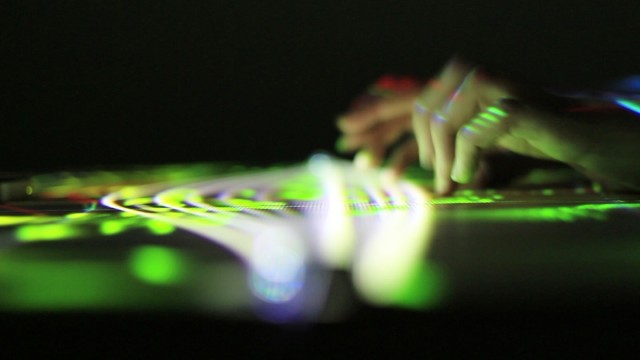
CONTACT is an experimental tangible audio interface, designed to manipulate and visualize sounds generated from interaction with a simple tabletop.
Any physical contact with the table generates acoustic vibrations, which are manipulated and visualized, in realtime. Here’s a preview of CONTACT in action:
The second video, below, looks at the tech behind CONTACT:
Features:
- The installation uses contact microphones, passive sonar and waveform analysis to capture the sound received from the contact microphones.
- The sound is then digitally ‘resonated’ to produce a melodic note from the original acoustic impulse.
- A LEAP Motion controller is also used to manipulate the sounds with various hand gestures, avoiding contact with the table.
- Projections visualise the impulses and vibrations generated from playing the Contact table, creating a live audio visual performance instrument.
CONTACT was created by Felix Faire. He plans to open source the code and make it available on github.

Awesome idea and concept!
now we’re talkin’!
Gimme that in the AppStore for £9.99!!
Hey doodadiddywhoppeydo
Try Impaktor + Wand for a cheap alternative 😉
D.
Impaktor already does this…
This looks absolutely stunning….
i call bullshit on the leap integration – it should be off the table and away from the projectors light
I want it!
What an interesting species we are. Sixty-five years ago, electronic instruments did not exist. Now we are verging on the stuff of science fiction. Of course, it was only sixty-two years between the first powered flight and the first human footprint on the Moon, so things like this shouldn’t really be that surprising. I imagine we’ll have a working Starship Enterprise by the end of the century, complete with warp drive, phasers, photon torpedoes and matter transporters. All of that technology is in development, too. A very interesting species.
Well put
All I can add is, if I were a member of another race, like the Klingon or Vulcan, Romulan or Andorian, watching us humans, I would be scared to death.
awesome to see cool take on vibration detection surface interfaces. I was working on something similar last year. It turned out that contact microphones are not ideal, at least in my case, because the interface relies heavy on the uniform structure of the surface. I got better results working with pair of the sensors (one vibration detection and second piezo film vibration detection) here is installation in action:
http://vimeo.com/84408124
And it was 66 years between Kitty Hawk and Tranquility. I always get the date wrong.